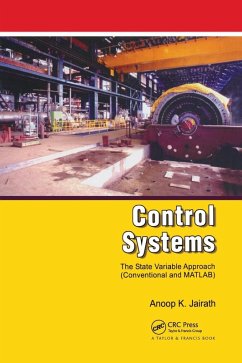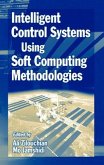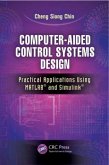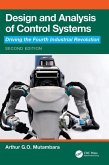Control Systems
A State Variable Approach
Herausgeber: Jairath, Anoop K.
Control Systems
A State Variable Approach
Herausgeber: Jairath, Anoop K.
- Gebundenes Buch
- Merkliste
- Auf die Merkliste
- Bewerten Bewerten
- Teilen
- Produkt teilen
- Produkterinnerung
- Produkterinnerung
Easily read and understood, this book offers a simple and practical approach to the study and analysis of control systems. It integrates MATLAB examples with the conventional approach and includes solved problems and examples in each chapter. The initial chapters are devoted to the basic study of the control system and understanding of MATLAB so that readers need not consult any other book.
Andere Kunden interessierten sich auch für
![Sliding Mode Control of Semi-Markovian Jump Systems Sliding Mode Control of Semi-Markovian Jump Systems]() Baoping JiangSliding Mode Control of Semi-Markovian Jump Systems168,99 €
Baoping JiangSliding Mode Control of Semi-Markovian Jump Systems168,99 €![Intelligent Control Systems Using Soft Computing Methodologies Intelligent Control Systems Using Soft Computing Methodologies]() Ali Zilouchian (ed.)Intelligent Control Systems Using Soft Computing Methodologies163,99 €
Ali Zilouchian (ed.)Intelligent Control Systems Using Soft Computing Methodologies163,99 €![Underwater Vehicle Control and Communication Systems Based on Machine Learning Techniques Underwater Vehicle Control and Communication Systems Based on Machine Learning Techniques]() Underwater Vehicle Control and Communication Systems Based on Machine Learning Techniques139,99 €
Underwater Vehicle Control and Communication Systems Based on Machine Learning Techniques139,99 €![Computer-Aided Control Systems Design Computer-Aided Control Systems Design]() Cheng Siong ChinComputer-Aided Control Systems Design237,99 €
Cheng Siong ChinComputer-Aided Control Systems Design237,99 €![Design and Analysis of Control Systems Design and Analysis of Control Systems]() Arthur G. O. MutambaraDesign and Analysis of Control Systems212,99 €
Arthur G. O. MutambaraDesign and Analysis of Control Systems212,99 €![Diagnostic, Reliablility and Control Systems Diagnostic, Reliablility and Control Systems]() Cornelius T. Leondes (ed.)Diagnostic, Reliablility and Control Systems325,99 €
Cornelius T. Leondes (ed.)Diagnostic, Reliablility and Control Systems325,99 €![Robust H¿ Team Formation Tracking Design Methods of Large-Scale UAV Networked Control Systems Robust H¿ Team Formation Tracking Design Methods of Large-Scale UAV Networked Control Systems]() Bor-Sen ChenRobust H¿ Team Formation Tracking Design Methods of Large-Scale UAV Networked Control Systems110,99 €
Bor-Sen ChenRobust H¿ Team Formation Tracking Design Methods of Large-Scale UAV Networked Control Systems110,99 €-
-
-
Easily read and understood, this book offers a simple and practical approach to the study and analysis of control systems. It integrates MATLAB examples with the conventional approach and includes solved problems and examples in each chapter. The initial chapters are devoted to the basic study of the control system and understanding of MATLAB so that readers need not consult any other book.
Produktdetails
- Produktdetails
- Verlag: CRC Press
- Seitenzahl: 364
- Erscheinungstermin: 1. August 2008
- Englisch
- Abmessung: 260mm x 183mm x 24mm
- Gewicht: 879g
- ISBN-13: 9781420077575
- ISBN-10: 1420077570
- Artikelnr.: 25412003
- Herstellerkennzeichnung
- Libri GmbH
- Europaallee 1
- 36244 Bad Hersfeld
- gpsr@libri.de
- Verlag: CRC Press
- Seitenzahl: 364
- Erscheinungstermin: 1. August 2008
- Englisch
- Abmessung: 260mm x 183mm x 24mm
- Gewicht: 879g
- ISBN-13: 9781420077575
- ISBN-10: 1420077570
- Artikelnr.: 25412003
- Herstellerkennzeichnung
- Libri GmbH
- Europaallee 1
- 36244 Bad Hersfeld
- gpsr@libri.de
Anoop K. JairathAnoop Kumar Jairath completed his graduation in Electrical Engineering and post-graduation in Control Systems from a reputed College in India. An electrical engineer by profession, he has been teaching control systems to undergraduate students for over 2 decades now. Deeply interested in research in this field, he has served as a project guide in a number of research projects. And has helped number graduates in getting their post-graduation. He is presently involved in policy making and providing consultancy in the field of electrical engineering. Based on his academic excellence, practical experience and contribution. He has been selected as Chartered Engineer and nominated as Fellow by the Institute of Engineers and also as a Fellow of the Institute of Electrical and Electronics Engineers of India. He is also a member of the Committee of the Bureau of. Indian standards for forming standards for primary and secondary batteries.
Preface, Chapter 1 Introduction 1.1 Introduction 1.2 Basic Steps to Design
a Control System 1.3 Mathematical Representation Chapter 2 Matrices 2.1
Introduction 2.2 Definition of Matrix 2.3 Square Matrix 2.4 Column Matrix
or Vector 2.5 Row Matrix or Vector 2.6 Diagonal Matrix 2.7 Identity Matrix
2.8 NullMatrix 2.9 Symmetrie Matrix 2.10 Determinant of Matrix 7 2.11
Matrix Algebra 2.12 Transpose of a Matrix 2.13 Adjoint of a Matrix 2.14
Inverse of a Matrix 2.15 Rank of a Matrix 2.16 Trace of a Matrix 2.17
Derivative of a Matrix 2.18 Exponential of a Matrix Chapter 3 Laplace
Transform 3.1 lntroduction 3.2 Definition of Laplace Transform 3.3 Laplace
Theorems 3.4 Laplace Transform Theorems 3.5 Important Laplace Transform
Pairs 3.6 Inverse Laplace Transform 3.7 Partial-Fraction Expansion Method
3.8 Convolution Integral 3.9 Solution of Differential Equations 3.10
Conclusion Chapter 4 MATLAB Basics 4.1 Introduction 4.2 MATLAB Environment
4.3 MATLAB Features 4.4 Vectors 4.5 Matrices 4.6 Eigenvalues and
Eigenvectors 4.7 Transfer Functions 4.8 Polynomials 4.9 Partial Fractions
4.10 Symbolic Math Commands Chapter 5 Control System: Basic Theory 5.1
Introduction 5.2 Definition 5.3 Classification 5.4 General Classification
5.5 Elements of a Feedback Control System 5.6 Representation of Control
Systems 5.7 Mason's Gain Formula 5.8 Conclusion Chapter 6 State-Space
Concepts and Analysis of State-Equations 6.1 Introduction 6.2 Basicerms 6.3
Trajectories in State Space 6.4 Nonlinearities and Linearisation6.5 State
Equation 6.6 State Equation: Homogenaus and Non-Homogenaus Parts 6.7
Solution ofNon-Homogeneous State Equations 6.8 Solution of Non-Homogenaus
Time-Invariant Matrix Differential Equation 6.9 Solution ofHomogenous
Time-lnvariant Matrix Differential Equation 6.10 State-Transition Matrix
6.11 Properties of State Transition Matrix 6.12 Computation of State
Transition Matrix 6.13 Laplace Transform Solution of State-Equations
(Frequency-Domain Analysis) 6.14 Transfer Function Matrix 6.15
Representation of State-Equation Solution in Terms of lj>(t) 6.16
Characteristic Equation 6.17 MATLAB Chapter 7 State-Space Modelling 7.1
lntroduction 7.2 State-Variable Diagram 7.3 State Models: Signal Flow
Graphs 7.4 State Models-Various Forms 7.5 Similarity Transformations 7.6
Other Useful Transformation 7.7 Decomposition of Transfer Function 7.8
MATLAB Chapter 8 Controllability and Observability 8.1 lntroduction 8.2
Cantrollability and Observability 8.3 Definition 8.4 Cantrollability Tests
8.5 Rank of a Matrix 8.6 Observability Tests 8.7 Output Cantrollability 8.8
Pole-zero Cancellation in Transfer Function 8.9 Duality
Theorem/Principle/Property 8.10 Design 8.11 Ackermann's Formula 8.12 MATLAB
Summary 314 Problems and Solutions, Review Exercise, References, Index.
a Control System 1.3 Mathematical Representation Chapter 2 Matrices 2.1
Introduction 2.2 Definition of Matrix 2.3 Square Matrix 2.4 Column Matrix
or Vector 2.5 Row Matrix or Vector 2.6 Diagonal Matrix 2.7 Identity Matrix
2.8 NullMatrix 2.9 Symmetrie Matrix 2.10 Determinant of Matrix 7 2.11
Matrix Algebra 2.12 Transpose of a Matrix 2.13 Adjoint of a Matrix 2.14
Inverse of a Matrix 2.15 Rank of a Matrix 2.16 Trace of a Matrix 2.17
Derivative of a Matrix 2.18 Exponential of a Matrix Chapter 3 Laplace
Transform 3.1 lntroduction 3.2 Definition of Laplace Transform 3.3 Laplace
Theorems 3.4 Laplace Transform Theorems 3.5 Important Laplace Transform
Pairs 3.6 Inverse Laplace Transform 3.7 Partial-Fraction Expansion Method
3.8 Convolution Integral 3.9 Solution of Differential Equations 3.10
Conclusion Chapter 4 MATLAB Basics 4.1 Introduction 4.2 MATLAB Environment
4.3 MATLAB Features 4.4 Vectors 4.5 Matrices 4.6 Eigenvalues and
Eigenvectors 4.7 Transfer Functions 4.8 Polynomials 4.9 Partial Fractions
4.10 Symbolic Math Commands Chapter 5 Control System: Basic Theory 5.1
Introduction 5.2 Definition 5.3 Classification 5.4 General Classification
5.5 Elements of a Feedback Control System 5.6 Representation of Control
Systems 5.7 Mason's Gain Formula 5.8 Conclusion Chapter 6 State-Space
Concepts and Analysis of State-Equations 6.1 Introduction 6.2 Basicerms 6.3
Trajectories in State Space 6.4 Nonlinearities and Linearisation6.5 State
Equation 6.6 State Equation: Homogenaus and Non-Homogenaus Parts 6.7
Solution ofNon-Homogeneous State Equations 6.8 Solution of Non-Homogenaus
Time-Invariant Matrix Differential Equation 6.9 Solution ofHomogenous
Time-lnvariant Matrix Differential Equation 6.10 State-Transition Matrix
6.11 Properties of State Transition Matrix 6.12 Computation of State
Transition Matrix 6.13 Laplace Transform Solution of State-Equations
(Frequency-Domain Analysis) 6.14 Transfer Function Matrix 6.15
Representation of State-Equation Solution in Terms of lj>(t) 6.16
Characteristic Equation 6.17 MATLAB Chapter 7 State-Space Modelling 7.1
lntroduction 7.2 State-Variable Diagram 7.3 State Models: Signal Flow
Graphs 7.4 State Models-Various Forms 7.5 Similarity Transformations 7.6
Other Useful Transformation 7.7 Decomposition of Transfer Function 7.8
MATLAB Chapter 8 Controllability and Observability 8.1 lntroduction 8.2
Cantrollability and Observability 8.3 Definition 8.4 Cantrollability Tests
8.5 Rank of a Matrix 8.6 Observability Tests 8.7 Output Cantrollability 8.8
Pole-zero Cancellation in Transfer Function 8.9 Duality
Theorem/Principle/Property 8.10 Design 8.11 Ackermann's Formula 8.12 MATLAB
Summary 314 Problems and Solutions, Review Exercise, References, Index.
Preface, Chapter 1 Introduction 1.1 Introduction 1.2 Basic Steps to Design
a Control System 1.3 Mathematical Representation Chapter 2 Matrices 2.1
Introduction 2.2 Definition of Matrix 2.3 Square Matrix 2.4 Column Matrix
or Vector 2.5 Row Matrix or Vector 2.6 Diagonal Matrix 2.7 Identity Matrix
2.8 NullMatrix 2.9 Symmetrie Matrix 2.10 Determinant of Matrix 7 2.11
Matrix Algebra 2.12 Transpose of a Matrix 2.13 Adjoint of a Matrix 2.14
Inverse of a Matrix 2.15 Rank of a Matrix 2.16 Trace of a Matrix 2.17
Derivative of a Matrix 2.18 Exponential of a Matrix Chapter 3 Laplace
Transform 3.1 lntroduction 3.2 Definition of Laplace Transform 3.3 Laplace
Theorems 3.4 Laplace Transform Theorems 3.5 Important Laplace Transform
Pairs 3.6 Inverse Laplace Transform 3.7 Partial-Fraction Expansion Method
3.8 Convolution Integral 3.9 Solution of Differential Equations 3.10
Conclusion Chapter 4 MATLAB Basics 4.1 Introduction 4.2 MATLAB Environment
4.3 MATLAB Features 4.4 Vectors 4.5 Matrices 4.6 Eigenvalues and
Eigenvectors 4.7 Transfer Functions 4.8 Polynomials 4.9 Partial Fractions
4.10 Symbolic Math Commands Chapter 5 Control System: Basic Theory 5.1
Introduction 5.2 Definition 5.3 Classification 5.4 General Classification
5.5 Elements of a Feedback Control System 5.6 Representation of Control
Systems 5.7 Mason's Gain Formula 5.8 Conclusion Chapter 6 State-Space
Concepts and Analysis of State-Equations 6.1 Introduction 6.2 Basicerms 6.3
Trajectories in State Space 6.4 Nonlinearities and Linearisation6.5 State
Equation 6.6 State Equation: Homogenaus and Non-Homogenaus Parts 6.7
Solution ofNon-Homogeneous State Equations 6.8 Solution of Non-Homogenaus
Time-Invariant Matrix Differential Equation 6.9 Solution ofHomogenous
Time-lnvariant Matrix Differential Equation 6.10 State-Transition Matrix
6.11 Properties of State Transition Matrix 6.12 Computation of State
Transition Matrix 6.13 Laplace Transform Solution of State-Equations
(Frequency-Domain Analysis) 6.14 Transfer Function Matrix 6.15
Representation of State-Equation Solution in Terms of lj>(t) 6.16
Characteristic Equation 6.17 MATLAB Chapter 7 State-Space Modelling 7.1
lntroduction 7.2 State-Variable Diagram 7.3 State Models: Signal Flow
Graphs 7.4 State Models-Various Forms 7.5 Similarity Transformations 7.6
Other Useful Transformation 7.7 Decomposition of Transfer Function 7.8
MATLAB Chapter 8 Controllability and Observability 8.1 lntroduction 8.2
Cantrollability and Observability 8.3 Definition 8.4 Cantrollability Tests
8.5 Rank of a Matrix 8.6 Observability Tests 8.7 Output Cantrollability 8.8
Pole-zero Cancellation in Transfer Function 8.9 Duality
Theorem/Principle/Property 8.10 Design 8.11 Ackermann's Formula 8.12 MATLAB
Summary 314 Problems and Solutions, Review Exercise, References, Index.
a Control System 1.3 Mathematical Representation Chapter 2 Matrices 2.1
Introduction 2.2 Definition of Matrix 2.3 Square Matrix 2.4 Column Matrix
or Vector 2.5 Row Matrix or Vector 2.6 Diagonal Matrix 2.7 Identity Matrix
2.8 NullMatrix 2.9 Symmetrie Matrix 2.10 Determinant of Matrix 7 2.11
Matrix Algebra 2.12 Transpose of a Matrix 2.13 Adjoint of a Matrix 2.14
Inverse of a Matrix 2.15 Rank of a Matrix 2.16 Trace of a Matrix 2.17
Derivative of a Matrix 2.18 Exponential of a Matrix Chapter 3 Laplace
Transform 3.1 lntroduction 3.2 Definition of Laplace Transform 3.3 Laplace
Theorems 3.4 Laplace Transform Theorems 3.5 Important Laplace Transform
Pairs 3.6 Inverse Laplace Transform 3.7 Partial-Fraction Expansion Method
3.8 Convolution Integral 3.9 Solution of Differential Equations 3.10
Conclusion Chapter 4 MATLAB Basics 4.1 Introduction 4.2 MATLAB Environment
4.3 MATLAB Features 4.4 Vectors 4.5 Matrices 4.6 Eigenvalues and
Eigenvectors 4.7 Transfer Functions 4.8 Polynomials 4.9 Partial Fractions
4.10 Symbolic Math Commands Chapter 5 Control System: Basic Theory 5.1
Introduction 5.2 Definition 5.3 Classification 5.4 General Classification
5.5 Elements of a Feedback Control System 5.6 Representation of Control
Systems 5.7 Mason's Gain Formula 5.8 Conclusion Chapter 6 State-Space
Concepts and Analysis of State-Equations 6.1 Introduction 6.2 Basicerms 6.3
Trajectories in State Space 6.4 Nonlinearities and Linearisation6.5 State
Equation 6.6 State Equation: Homogenaus and Non-Homogenaus Parts 6.7
Solution ofNon-Homogeneous State Equations 6.8 Solution of Non-Homogenaus
Time-Invariant Matrix Differential Equation 6.9 Solution ofHomogenous
Time-lnvariant Matrix Differential Equation 6.10 State-Transition Matrix
6.11 Properties of State Transition Matrix 6.12 Computation of State
Transition Matrix 6.13 Laplace Transform Solution of State-Equations
(Frequency-Domain Analysis) 6.14 Transfer Function Matrix 6.15
Representation of State-Equation Solution in Terms of lj>(t) 6.16
Characteristic Equation 6.17 MATLAB Chapter 7 State-Space Modelling 7.1
lntroduction 7.2 State-Variable Diagram 7.3 State Models: Signal Flow
Graphs 7.4 State Models-Various Forms 7.5 Similarity Transformations 7.6
Other Useful Transformation 7.7 Decomposition of Transfer Function 7.8
MATLAB Chapter 8 Controllability and Observability 8.1 lntroduction 8.2
Cantrollability and Observability 8.3 Definition 8.4 Cantrollability Tests
8.5 Rank of a Matrix 8.6 Observability Tests 8.7 Output Cantrollability 8.8
Pole-zero Cancellation in Transfer Function 8.9 Duality
Theorem/Principle/Property 8.10 Design 8.11 Ackermann's Formula 8.12 MATLAB
Summary 314 Problems and Solutions, Review Exercise, References, Index.









